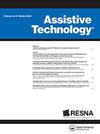Toshiki Kobayashi, Sarah R Chang, Jessica Garries, Jung Kim, Shaghayegh Mirbaha, Sander L Hitzig, Amanda L Mayo, Silvia Raschke, Adam K Arabian, David A Boone
求助PDF
{"title":"COMET(临床结果测量电子工具包)移动应用程序的可用性测试,用于收集下肢截肢患者和临床医生的结果测量数据。","authors":"Toshiki Kobayashi, Sarah R Chang, Jessica Garries, Jung Kim, Shaghayegh Mirbaha, Sander L Hitzig, Amanda L Mayo, Silvia Raschke, Adam K Arabian, David A Boone","doi":"10.1080/10400435.2025.2555241","DOIUrl":null,"url":null,"abstract":"<p><p>Evidence-based clinical care and outcomes research are essential for developing objectively based standards of practice in prosthetic and orthotic care. Traditionally, outcome measures have been collected using paper-based methods. However, digital collection of these measures may offer several advantages. The COMET© (Clinical Outcome Measures Electronic Toolkit) mobile app was developed to facilitate the assessment of commonly used patient-reported and performance-based outcome measures in prosthetics and orthotics. The usability of the COMET app was evaluated among 15 individuals with lower limb amputation and nine clinicians using the System Usability Scale (SUS). The mean SUS score among individuals with lower limb amputation was 84 ± 12 (Grade: A; Percentile: 90-95; Adjective: Excellent; Acceptable), and the mean SUS score among the clinicians was 80 ± 14 (Grade: A-; Percentile: 85-89; Adjective: Good; Acceptable). There were no significant differences in SUS score between the two groups, indicating that the app was acceptable to both groups of participants in clinical settings.</p>","PeriodicalId":51568,"journal":{"name":"Assistive Technology","volume":" ","pages":"1-7"},"PeriodicalIF":2.5000,"publicationDate":"2025-09-23","publicationTypes":"Journal Article","fieldsOfStudy":null,"isOpenAccess":false,"openAccessPdf":"","citationCount":"0","resultStr":"{\"title\":\"Usability testing of the COMET (Clinical Outcome Measures Electronic Toolkit) mobile app for outcome measure data collection in individuals with lower limb amputation and clinicians.\",\"authors\":\"Toshiki Kobayashi, Sarah R Chang, Jessica Garries, Jung Kim, Shaghayegh Mirbaha, Sander L Hitzig, Amanda L Mayo, Silvia Raschke, Adam K Arabian, David A Boone\",\"doi\":\"10.1080/10400435.2025.2555241\",\"DOIUrl\":null,\"url\":null,\"abstract\":\"<p><p>Evidence-based clinical care and outcomes research are essential for developing objectively based standards of practice in prosthetic and orthotic care. Traditionally, outcome measures have been collected using paper-based methods. However, digital collection of these measures may offer several advantages. The COMET© (Clinical Outcome Measures Electronic Toolkit) mobile app was developed to facilitate the assessment of commonly used patient-reported and performance-based outcome measures in prosthetics and orthotics. The usability of the COMET app was evaluated among 15 individuals with lower limb amputation and nine clinicians using the System Usability Scale (SUS). The mean SUS score among individuals with lower limb amputation was 84 ± 12 (Grade: A; Percentile: 90-95; Adjective: Excellent; Acceptable), and the mean SUS score among the clinicians was 80 ± 14 (Grade: A-; Percentile: 85-89; Adjective: Good; Acceptable). There were no significant differences in SUS score between the two groups, indicating that the app was acceptable to both groups of participants in clinical settings.</p>\",\"PeriodicalId\":51568,\"journal\":{\"name\":\"Assistive Technology\",\"volume\":\" \",\"pages\":\"1-7\"},\"PeriodicalIF\":2.5000,\"publicationDate\":\"2025-09-23\",\"publicationTypes\":\"Journal Article\",\"fieldsOfStudy\":null,\"isOpenAccess\":false,\"openAccessPdf\":\"\",\"citationCount\":\"0\",\"resultStr\":null,\"platform\":\"Semanticscholar\",\"paperid\":null,\"PeriodicalName\":\"Assistive Technology\",\"FirstCategoryId\":\"3\",\"ListUrlMain\":\"https://doi.org/10.1080/10400435.2025.2555241\",\"RegionNum\":4,\"RegionCategory\":\"医学\",\"ArticlePicture\":[],\"TitleCN\":null,\"AbstractTextCN\":null,\"PMCID\":null,\"EPubDate\":\"\",\"PubModel\":\"\",\"JCR\":\"Q1\",\"JCRName\":\"REHABILITATION\",\"Score\":null,\"Total\":0}","platform":"Semanticscholar","paperid":null,"PeriodicalName":"Assistive Technology","FirstCategoryId":"3","ListUrlMain":"https://doi.org/10.1080/10400435.2025.2555241","RegionNum":4,"RegionCategory":"医学","ArticlePicture":[],"TitleCN":null,"AbstractTextCN":null,"PMCID":null,"EPubDate":"","PubModel":"","JCR":"Q1","JCRName":"REHABILITATION","Score":null,"Total":0}
引用次数: 0
引用
批量引用

 求助内容:
求助内容: 应助结果提醒方式:
应助结果提醒方式:


